
How blockchain technology is changing treasury

Reducing the cost of collecting international receivables

6 timely reasons to integrate your receivables

Webinar: Cash management strategies for higher education

Colleges respond to student needs by offering digital payments

Benefits of billing foreign customers in their own currency

Webinar: Digitizing receivables to transform B2B rent payments

Improve government payments with electronic billing platforms

Emerging A/R solutions use artificial intelligence to target efficiency

Drivers for changing accounts receivable in 2021

Solutions banks can offer during the COVID-19 pandemic

Integrated receivables management solution supports customer focus at MSC Industrial Supply

Post-pandemic fraud prevention lessons for local governments

Webinar: Recording of the Central Securities Depository Regulation and Pivot

Authenticating cardholder data reduce e-commerce fraud

Webinar: Robotic process automation

Webinar: Digitize your AP processes to optimize results

Hospitals face cybersecurity risks in surprising new ways

Webinar: Empower your AP automation with strategic intelligence
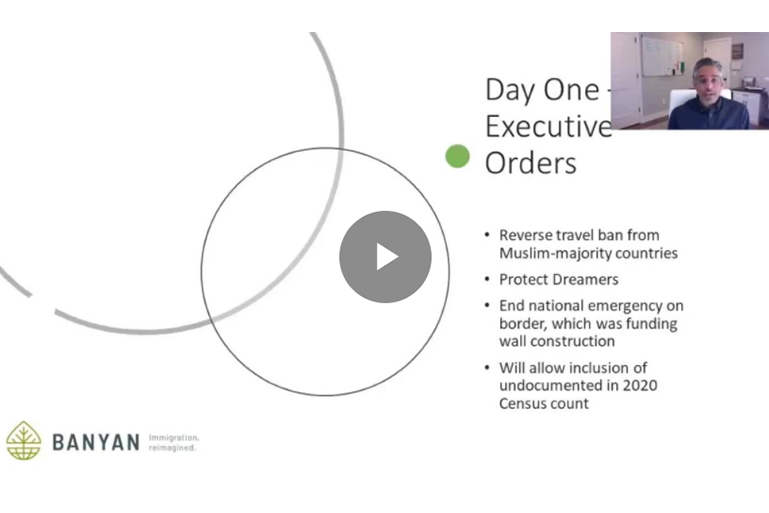
Webinar: Key issues impacting relocation in 2021
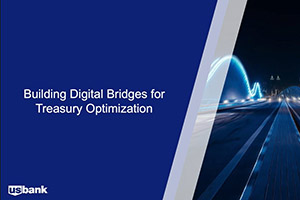
Webinar: Building digital bridges for treasury optimization

Webinar: CRE technology trends
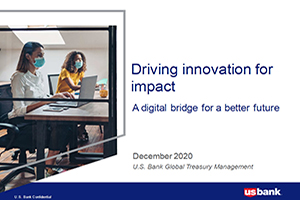
Webinar: Driving innovation to impact treasury management

Webinar: AP automation—solve payment challenges with an invoice-to-pay solution

Webinar: CRE treasury leader roundtable

5 Ways to protect your government agency from payment fraud
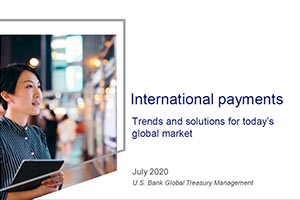
Webinar: International payments

Webinar: Economic, political and policy insights
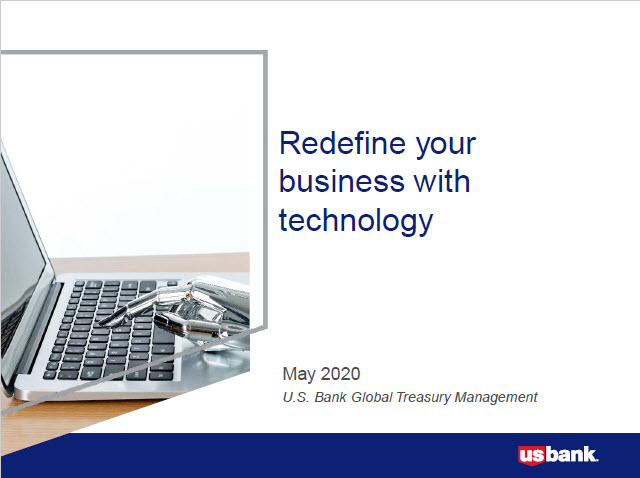
Webinar: Redefine your business with technology
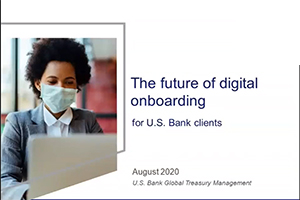
Webinar: The future of digital onboarding for U.S. Bank clients
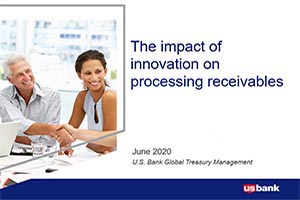
Webinar: The impact of innovation on processing receivables

5 reasons to upgrade B2B payment acceptance methods

Creating the ideal patient journey

Government agency credit card programs and PCI compliance

Leading the way for real-time payments

Transition to international ACH

Real-time answers about real-time payments

Beyond the back office: real-time payments

Webinar: Transform your business with automated payables

Real-time payments fuel innovation

Take a fresh look: mass transit is going places

Drive digital transformation with payments innovation

Making the cross-border payment decision: Wire or international ACH?

How the next evolution of consumer bill pay makes it easier to do business

Integrated payments healthcare benefits
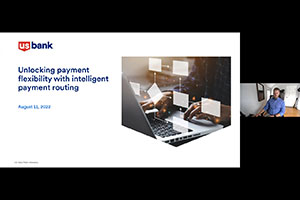
Unlocking payment flexibility with intelligent payment routing

Standardizing healthcare payments

Navigate changing consumer behavior with service fees

Consolidating payments for healthcare systems

Role of complementary new channels in your payments strategy

Higher education strategies for e-payment migration, fighting fraud

Payment industry trends that are the future of POS

How electronic billing platforms improve government payments

Modernizing fare payment without leaving any riders behind

What government officials should know about real-time payments

Escheatment resources: Reporting deadlines for all 50 states

How real-time inventory visibility can boost retail margins
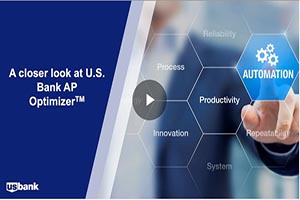
Webinar: Approaching international payment strategies in today’s unpredictable markets.

Access, flexibility and simplicity: How governments can modernize payments to help their citizens

Tap-to-pay: Modernizing fare payments pays off for transit agencies and riders

ABCs of APIs: Drive treasury efficiency with real-time connectivity

White Castle optimizes payment transactions

Three healthcare payment trends that will continue to matter in 2022

Managing the rising costs of payment acceptance with service fees

Restaurant survey shows changing customer payment preferences

Time is money: Intelligent Payment Routing saves businesses both

Want AP automation to pay both businesses and consumers?

Webinar: CSM corporation re-thinks AP

Digital trends poised to reshape hotel payments

How emerging banking solutions enable better decisions

Webinar: A closer look at U.S. Bank AP Optimizer

Banking connectivity: Helping businesses deliver the easier, faster, more secure customer experience of the future

Tech tools to keep your restaurant operations running smoothly

How to improve digital payments security for your health system

Luxury jeweler enhances the digital billing and payment customer experience

Enhancing the patient experience through people-centered payments

Adjust collections to limit impact of USPS delivery changes

Increase working capital with Commercial Card Optimization

Digital banking for business: How connectivity improves customer experience

Automate escheatment for accounts payable to save time and money

Top 3 ways digital payments can transform the patient experience

How COVID-19 is transforming healthcare payments

3 benefits of integrated payments in healthcare

Crack the SWIFT code for sending international wires

Automate accounts payable to optimize revenue and payments

Cashless business pros and cons: Should you make the switch?

Unexpected cost savings may be hiding in your payment strategy

A simple guide to set up your online ordering restaurant

ePOS cash register training tips and tricks

What to know when investing in AP automation solutions

Webinar: AP automation for commercial real estate

How AR technology is helping advance payment processing at Avera Health

Understanding and preparing for the new payment experience

3 ways to adapt to the new payments landscape

How to accept credit card payments without transaction fees

3 reasons governments and educational institutions should implement service fees

Ways prepaid cards disburse government funds to the unbanked

Principles to pursue in revitalizing Accounts Payable

Rent payments: What’s changing for commercial real estate

Collect utility and telecom bill payments faster

Safeguarding the payment experience through contactless

Higher education and the cashless society: Latest trends

Top tips for card payments optimization

Addressing financial uncertainty in international business

The benefits of payment digitization: Pushing for simplicity

COVID-19 safety recommendations: Are you ready to reopen?

Government billing survey: The digital transformation of the payment experience

Ease your transition to remote banking

5 winning strategies for managing liquidity in volatile times

The surprising truth about corporate cards

Instant Payments: Accelerating treasury disruption

3 ways to make practical use of real-time payments

The future of financial leadership: More strategy, fewer spreadsheets

Artificial intelligence in finance: Defining the terms

How AI in treasury management is transforming finance

Can faster payments mean better payments?

Zelle® helps Sunriver Resort make payments efficient and secure

Buried treasure: Maximizing analytics for treasury management

Protecting cash balances with sweep vehicles

Employee benefit plan management: trustee vs. custodian

4 benefits to paying foreign suppliers in their own currency

4 ways Request for Payments (RfP) changes consumer bill pay

3 timeless tips to reduce corporate payments fraud

Empowering managers with data automation and integration

OCIO: An expanding trend in the investment industry

Tech lifecycle refresh: A tale of two philosophies

Delivering powerful results with SWIFT messaging and services

Understanding the role of authorized participants in exchange-traded funds

Sophisticated investors reduce costs with block trading

Digital Onboarding helps finance firm’s clients build communities

Managing complex transactions: what your corporate trustee should be doing

Technology Financing

At your service: outsourcing loan agency work

The client-focused mindset: Adapting to differing personality types

Save time with mobile apps for business finances

Flexibility remains essential for public sector workforces

What corporate treasurers need to know about Virtual Account Management

How RIAs can embrace technology to enhance personal touch

Webinar: CRE Digital Transformation – Balancing Digitization with cybersecurity risk

ABCs of ARP: Answers to American Rescue Plan questions for counties

Innovative payroll solutions may help attract hourly workers

Automated escheatment – learn how to prevent and resolve unclaimed property

Tailor Ridge eBill case study

CFO survey: A shifting focus on ESG in business

Webinar: Fraud prevention and mitigation for government agencies

Webinar: Reviving mobility, what to expect

CFO insights: Leading the recovery for sustainable growth

Digital receivables to meet changing demand

CFO report: Driving growth via new business models and technology

Mobile treasury management – redesigned with your business in mind

Overcoming the 3 key challenges of a lump sum relocation program

Webinar: DEI tips for transforming your mobility program

Webinar: Navigating today’s work-from-anywhere world

Treasury management innovations earn Model Bank awards

Streamline operations with all-in-one small business financial support

How mobile point of sale (mPOS) can benefit your side gig

Checklist: What you’ll need for your first retail pop-up shop

Key considerations for online ordering systems

Rethinking common time management tips

Business credit card 101

Using merchant technology manage limited staffing

How to apply for a business credit card

What kind of credit card does my small business need?

How jumbo loans can help home buyers and your builder business

Do I need a credit card for my small business?

How a small business is moving forward during COVID-19

5 tips to help you land a small business loan

How Everyday Funding can improve cash flow

How to accept credit cards online

How I did it: Switched career paths by taking an unexpected pivot

Tips for navigating a medical hardship when you’re unable to work

When your spouse has passed away: A three-month financial checklist

Student checklist: Preparing for college

Tips to earn that A+ in back-to-school savings

How to save money in college: easy ways to spend less

The A to Z’s of college loan terms

Co-signing 101: Applying for a loan with co-borrower

How to build credit as a student

5 things to know before accepting a first job offer
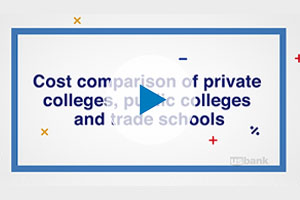
Webinar: Bank Notes: College cost comparison

What’s your financial IQ? Game-night edition

How to choose the right rewards credit card for you

3 awkward situations Zelle can help avoid

Dear Money Mentor: How do I set and track financial goals?

5 reasons why couples may have separate bank accounts

5 tips to use your credit card wisely and steer clear of debt

How voice-activated devices work with banks

P2P payments make it easier to split the tab

Parent checklist: Preparing for college

How to open and invest in a 529 plan

Is a home equity loan for college the right choice for your student

Be careful when taking out student loans

Using 529 plans for K-12 tuition

How grandparents can contribute to college funds instead of buying gifts

How to apply for federal student aid through the FAFSA

5 tips to use your credit card wisely and steer clear of debt

5 steps to selecting your first credit card

Dear Money Mentor: How do I begin paying off credit card debt?

How to use credit cards wisely for a vacation budget

7 steps to keep your personal and business finances separate

Money Moments: How to finance a home addition

What applying for store credit card on impulse could mean

5 unique ways to take your credit card benefits further

6 essential credit report terms to know

How to spot a credit repair scam

Myth vs. truth: What affects your credit score?

Should you give your child a college credit card?

Test your loan savvy

Credit: Do you understand it?

